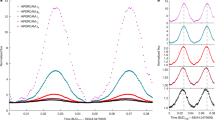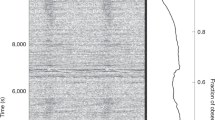Abstract
The four known binary radio pulsars (Table 1) seem to fall into two different categories. Two of them, PSR0655 + 64 and PSR1913 + 16, have short orbital periods (<25 h)1,2and high mass functions, indicating companion masses >0.8 M⊙ (respectively, about 1 M⊙ and 1.4 M⊙ (ref. 2)). The other two, PSR0820 + 02 and PSR1953 + 29, have long orbital periods (≳ 120 days), nearly circular orbits and low almost identical mass functions of ∼3 × 10−3 M⊙, suggesting companion masses of ∼0.2–0.4 M⊙ (refs 3–5). We point out here that these two classes of systems are expected to be formed by the later evolution of binaries consisting of a neutron star and a normal companion star, in which the companion was (considerably) more massive than the neutron star, or less massive than the neutron star, respectively. Mass transfer from an evolved companion that is more massive than the neutron star (more precisely, mass ratio ⩾0.85 (refs 6, 7)) tends to be unstable and to lead to runaway mass transfer and spiral-in resulting in a very short orbital period, whereas mass transfer from an evolved companion that is less massive than the neutron star is stable and leads to expansion of the orbit6,7. Furthermore, we point out that in the systems with a less massive companion, the neutron star most probably was formed by the accretion-induced collapse of a white dwarf. Such a model explains in a natural way why PSR1953 + 29 has a millisecond rotation period and why PSR0820 + 02 has not.
This is a preview of subscription content, access via your institution
Access options
Subscribe to this journal
Receive 51 print issues and online access
$199.00 per year
only $3.90 per issue
Buy this article
- Purchase on Springer Link
- Instant access to full article PDF
Prices may be subject to local taxes which are calculated during checkout
Similar content being viewed by others
References
Taylor, J. H. & Weisberg, J. M. Astrophys. J. 253, 908–920 (1983).
Damashak, M., Backus, P. R., Taylor, J. H. & Burkhardt, R. Astrophys, J. Lett. 253, L57–L60 (1982).
Taylor, J. H. IAU Symp. 95, 361–369 (1981).
Manchester, R. N. et al. Astrophys. J. 268, 832–836 (1983).
Boriakoff, V., Buccheri, R. & Fanci, F. Nature 304, 417–419 (1983).
Plavec, M. Adv. Astr. Astrophys. 6, 201–278 (1968).
Paczynski, B. A. Rev. Astr. Astrophys. 9, 183–208 (1971).
Paczynski, B. & Sienkiewicz, R. Acta Astr. 22, 73–91 (1972).
Paczynski, B. IAU Symp. 73, 75–80 (1976).
Webbink, R. F. IAU Colloq. 53, 426 (1979).
Taam, R. E., Bodenheimer, P. & Ostriker, J.P. Astrophys. J. 222, 269–280 (1978).
Meyer, F. & Meyer-Hofmeister, E. Astr. Astrophys. 78, 167–176 (1979).
Bodenheimer, P. & Taam, R. E. Astrophys. J. (in the press).
Paczynski, B. Acta Astr. 20, 47–58 (1970).
Habets, G. IAU Symp. 105 (in the press).
Delgado, A. J. & Thomas, H. C. Astr. Astrophys. 96, 142–145 (1981).
Iben, I. A Rev. Astr. Astrophys. 12, 215–256 (1974).
Becker, S. A. Astrophys. J. Suppl. Ser. 45, 475–505 (1981).
Van den Heuvel, E. P. J. IAU Symp. 93, 155–175 (1981).
Flannery, B. P. & Van den Heuvel, E. P. J. Astr. Astrophys. 39, 61–67 (1975).
Srinivasan, G. & Van den Heuvel, E. P. J. Astr. Astrophys. 108, 143–147 (1982).
Smarr, L. L. & Blandford, R. Astrophys. J. 207, 574–588 (1976).
Lyne, A. IAU Symp. 95, 423–436 (1981).
Radhakrishnan, V. Proc. Asian Pacific IAU Regional Meet., Bandung (ed. Hidayat, B.) (Bandung University, in the press).
Flowers, E. & Ruderman, M. A. Astrophys. J. 215, 302–310 (1977).
Henrichs, H. in Accretion-driven Stellar X-ray Sources (eds Lewin, W. H. G. & Van den Heuvel, E. P. J.) Ch. 11 (Cambridge University Press, 1983).
Alpar, M. A., Cheng, A. R., Ruderman, M. A. & Shaham, J. Nature 300, 728–731 (1982).
Radhakrishan, V. & Srinivasan, G. Curr. Sci. 51, 1096–1099 (1982).
Rappaport, S. A. & Van den Heuvel, E. P. J. IAU Symp. 98, 327–346 (1982).
Priedhorsky, W. C. & Terrell, J. Nature 303, 681–683 (1983).
Webbink, R. F., Rappaport, A. A. & Savonije, G. J. Astrophys. J. 270, 678–693 (1983).
Taam, R. E. Astrophys. J. 270, 694–699 (1983).
Savonije, G. J. Nature 304, 422–423 (1983).
Paczynski, B. Nature 304, 421–422 (1983).
Joss, P. C. & Rappaport, S. A. Nature 304, 419–421 (1983).
Zahn, J. P. Astr. Astrophys. 57, 383–394 (1977); erratum 67, 162 (1978).
Savonije, G. J. Proc. Cambridge NATO Conf. on Interacting Binaries (Cambridge University Press, in the press).
Bradt, H. V. D. & McClintock, J. E. A. Rev. Astr. Astrophys. 28, 13–66 (1983).
Van den Heuvel, E. P. J. in Pulsars (eds Sieber, W. & Wielebinski, R.) 371–378 (Reidel, Dordrecht, (1981).).
Sion, E. M., Acierno, M. J. & Tomsczyk, S. Astrophys. J. 230, 832–838 (1979).
Nomoto, K. Space Sci. Rev. 27, 563–570 (1980).
Nomoto, K. Astrophys. J. 253, 798–810 (1982).
Stevenson, D. J. J. Phys. Suppl. 41, (3),C2–53 (1980).
Bravo, E., Isern, J., Labay, J. & Canal, R. Astr. Astrophys. 124, 39–42 (1983).
Blandford, P. D. & De Campli, W. M. . in Pulsars (eds Sieber, W. & Wielebinski, R.) 371–378 (Reidel, Dordrecht, (1983).).
Whelan, J. & Iben, I. Astrophys. J. 186, 1007–1014 (1973).
Helfand, D. J., Ruderman, M. A. & Shaham, J. Nature 304, 423–425 (1983).
Author information
Authors and Affiliations
Rights and permissions
About this article
Cite this article
van den Heuvel, E., Taam, R. Two types of binary radio pulsars with different evolutionary histories. Nature 309, 235–237 (1984). https://doi.org/10.1038/309235a0
Received:
Accepted:
Issue Date:
DOI: https://doi.org/10.1038/309235a0
This article is cited by
-
The population of binary and millisecond pulsars
Journal of Astrophysics and Astronomy (1995)
-
Scenarios for the formation of binary and millisecond pulsars – A critical assessment
Journal of Astrophysics and Astronomy (1995)
Comments
By submitting a comment you agree to abide by our Terms and Community Guidelines. If you find something abusive or that does not comply with our terms or guidelines please flag it as inappropriate.



